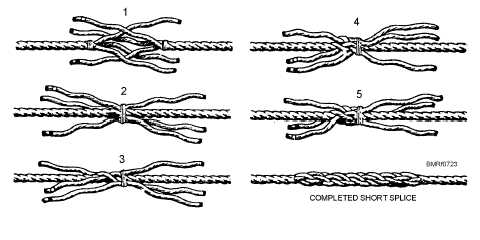the slack out of each tuck and check the size of the eye.
(If a thimble is to be used, insert it at this point.) Follow
the “over one strand, under the next” procedure until
you complete at least three tucks for natural fiber line or
four tucks for synthetic line. (NOTE: The splice can be
smoothed by rolling it on deck under your foot.)
Upon completion of the splice, the excess length of
each strand must be cut off. When natural fiber line is
used for the splice, the strands can simply be cut off near
the line. With synthetic line, a short length of each
strand should be left intact. The ends of the threads of
each strand are then melted together over an open flame
to prevent the strands from frazzling.
When you melt the ends of the strands, don’t allow
any of the melted synthetic line to drip on you, your
clothing, another person, or anything that might present
a fire hazard. Also, observe all safety precautions
pertaining to the use of open flames aboard your ship or
station.
Short Splice
A short splice is used where two lines are to be
permanently joined, provided a slight enlargement of
the diameter is not important. When properly made, the
short splice is much stronger than any knot.
After unlaying and whipping the strands as
described for the eye splice, seize each line where the
unlaying stops. Now butt the two lines together so that
they are interlaced, and follow the steps shown in figure
7-23.
With large lines, you must put on a temporary
seizing where they join to keep them from suddenly
coming apart. It’s better to do that with small lines, too,
until you get the hang of holding them together while
you tuck.
Once your seizing is on, tuck over and under the
same way you finish off an eye splice. Three tucks
(natural fiber) or four tucks (synthetic fiber) on each
side of the seizing are ample. Remove the seizing, cut
off the ends of the strands, and melt them (if
appropriate) as previously described.
SECURING FOR SEA
You are required to learn these knots, bends, and
hitches so that you can use them when and where
necessary. Rest assured that a person who goes to sea
will find frequent use for them in securing equipment to
prevent damage from rough waters. How the equipment
is secured depends on the gear and the places of
stowage. By observing the few tips that follow and by
using a little common sense, you should be able to do a
good job of securing your equipment for sea.
Use line strong enough to hold the gear.
Make certain the line is in good condition. Make
fast the belay objects from at least two points
that, preferably, are near the object.
Lash tightly all objects against something solid
(such as the bulkhead).
7-19
Student Notes:
Figure 7-23.—Steps for making a short splice.

